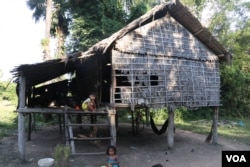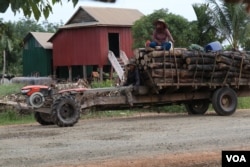Ol Thida and her husband were sure they had no choice but to leave their tiny rural village.
They couldn’t find work anywhere nearby. They owned almost nothing, not even the plot of land their palm-thatched hut was built on. They owed a microfinance institution $250, a debt whose principal never seemed to shrink, no matter how much of their spare cash they forked over to the bank. They were desperate to meet the deadline for repayment at the end of the year.
So Ol Thida’s husband, Prak Chea, left for Thailand to work as a laborer on a cassava farm and send his wages home. He told her to stay home to care for their two daughters and meager property: a few pots and pans, a few cows. He would send money home.
Left for Phnom Penh
But the debt was not getting smaller, despite the remittances. All Ol Thida could do for income was make baskets and catch fire ants to sell at the local market. Both of these brought paltry sums. She did not have the sewing skills to work at a garment factory. So she, too, decided to migrate. She left for Phnom Penh in October to look for a job as a waitress.
“I couldn’t even make 10,000 riel [$2.50] for my family,” said the 34-year-old mother of two. “How could I stay here?”
Her daughters, 7-year-old Meta and 14-year-old Leakhena, were growing up and would need more than she could provide if she stayed in the village. Once in Phnom Penh, she could send money home to them.
She arranged for the girls to sleep at her sister’s nearby home. She would call them every day on her sister’s phone, and Leakhena would cook meals for Meta in the family’s own hut. It was a risk, but seemed like the best option in a life of bad options.
Tragedy strikes
But the family’s new life quickly descended into tragedy.
Three days after she left for the capital city, on Oct. 18, Ol Thida called home as usual, but her sister couldn’t find the girls. Family members began searching for them, but they weren’t in any of the usual places: not in the hut, not in the rice field where they worked every day.
In despair, Ol Thida consulted a fortuneteller in the capital, who insisted the girls were in the hut. The search party returned to the house and opened a box in the hut that was used to store clothes. Inside were the bodies of Leakhena and Meta. The older child had been raped and strangled; the younger had been beaten.
A 25-year-old neighbor was arrested the next day for the crime. Chhum Poy was a distant relative; the girls had called him “uncle.” He confessed to police that he had taken advantage of their being home alone to drop by the hut and rape Leakhena. He admitted to strangling her, then beating and smothering Meta since she had witnessed the attack.
“The phone fell from my hand when I heard they were killed,” Ol Thida said.
She said she would not have dreamed her children were in danger of a violent crime in their tiny hometown, much less from a man they were so familiar with.
“I had never thought about rape in this village,” Ol Thida said.
Systemic problem
Meta’s and Leakhena’s deaths caught the public imagination and were widely discussed by Cambodians on social media, with many people blaming Ol Thida for leaving her children alone, or lamenting the decline of morality in Cambodian society.
But the truth is that there is a more systemic problem.
Stories like this are becoming more common in Cambodia, as migration from rural areas to Phnom Penh and Thailand is increasing rapidly, said Chhan Sokunthea, the head of the children’s rights unit at local rights group Adhoc.
The Cambodia Rural Urban Migration Project (CRUMP) found that the population of the capital city of Phnom Penh more than doubled from 1998 to 2012, from 567,860 to 1,237,600 residents, with an average annual of growth rate of about 8 percent. Cambodians also seek work in other countries such as South Korea and Malaysia.
“National police reports provide figures on movement out of home villages on a monthly basis,” the report said. “The reports capture the number of people who leave home villages in search of work. … According to this information, migration almost doubled from 2014 to 2015, with reports showing 450,845 people migrating or leaving villages in November 2015, compared with 241,375 people in November 2014.
The Cambodian government receives information about migration from Thailand. According to a census conducted by the Thai government in March 2015, there were more than 450,000 migrants from Cambodia working illegally in Thailand.
This demographic shift means that some villages are primarily populated by children, the elderly, and men who are unemployable because they use drugs or struggle with mental illness. But children are still expected to do traditional forms of labor, such as collecting forest products and herding cows, that bring them into remote parts of the countryside.
In Phsar commune alone, more than 500 people, mostly men and women in the prime of life, have migrated away from the countryside to work, according to Bin Sophan, the commune chief.
The suspect in the girls’ murder was not one of them. He used drugs and alcohol and did not work steadily, Bin Sophan said.
Those at greatest risk
Chhan Sokunthea said children from poor families whose parents were migrants were at greatest risk of physical and sexual abuse.
Nhep Sopheap, secretary-general at the Cambodia National Council for Children (CNCC), a government body, said she was “very concerned” about the effects on children of poverty and migration. She said the rape of children was of particular worry.
“We still have limited awareness in the countryside,” she said, adding that Cambodia was working on drafting a child protection law that dealt specifically with crimes against children and would fill gaps in the Criminal Code.
“Rape and sexual abuse remain a threat to the well-being of children in Cambodia, despite significant progress being made by the government to improve the protection of children from harm,” said Bunly Meas, a communications specialist at UNICEF, the United Nations’ children’s agency, which has been working with the Cambodian government on the law.
“It is important for parents and caregivers to ensure that young children are never left home alone as this exposes them to various forms of neglect and harm,” he added. “Children should be supervised at all times.”
The CRUMP survey found that of domestic migrants who left children behind, 82.4 percent left their children with grandparents, usually a grandmother whose average age is 62.4 years, and who circumstances are “difficult.”
Researchers found that families headed by grandparents alone struggled to consistently provide, according to the executive summary of a joint study by CNCC and UNICEF Cambodia. Many of the grandmothers told researchers they found the child care overwhelming.
“This little one is so active, I can never leave her alone,” one woman said. “I am too old to watch her properly, she is too active.”
But hiring a child-minder is impossible for families like Ol Thida’s, where the exigencies of eking out a living are in direct conflict with their children’s needs.
Donations to mother
Amid the social media frenzy over the girls’ deaths, Cambodians sent Ol Thida thousands of dollars in donations.
Bun Rany, the wife of Prime Minister Hun Sen, promised to build her a house and gave her $5,000 through the Cambodian Red Cross. She also helped organize a new job for her at a garment factory, inspecting buttons.
The rest of the donated money is being held by local officials, who say Ol Thida is not responsible enough to keep it herself, but have promised to use the funds to buy the family a plot of land and a motorbike.
With cruel irony, the loan has finally been paid off — but too late.
As she spoke to a journalist one day recently, Ol Thida was lighting incense to pray to the spirits of her daughters at a makeshift shrine she had set up in her hut.
“It was my mistake to leave my children alone, but this was because of the difficulties of my life,” she said. “Now I can’t even work properly — I am like a crazy person. I am suffering like the death to lose my two lovely daughters.”
Then she addressed her dead children. “Please don’t be unfortunate, like you were in this life!” she pleaded with their souls.











